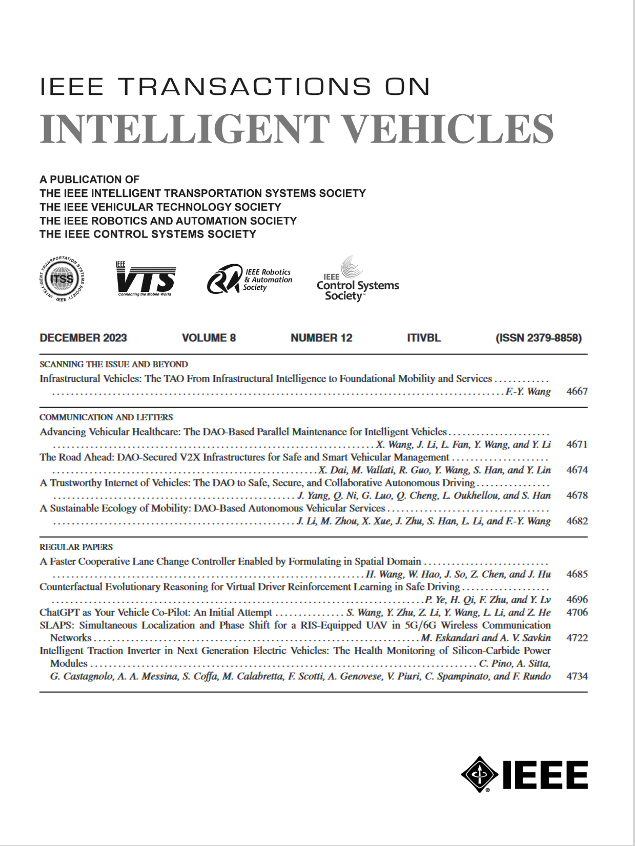Online, Target-Free LiDAR-Camera Extrinsic Calibration via Cross-Modal Mask Matching
IF 14.3
1区 工程技术
Q1 COMPUTER SCIENCE, ARTIFICIAL INTELLIGENCE
引用次数: 0
Abstract
LiDAR-camera extrinsic calibration (LCEC) is crucial for data fusion in intelligent vehicles. Offline, target-based approaches have long been the preferred choice in this field. However, they often demonstrate poor adaptability to real-world environments. This is largely because extrinsic parameters may change significantly due to moderate shocks or during extended operations in environments with vibrations. In contrast, online, target-free approaches provide greater adaptability yet typically lack robustness, primarily due to the challenges in cross-modal feature matching. Therefore, in this article, we unleash the full potential of large vision models (LVMs), which are emerging as a significant trend in the fields of computer vision and robotics, especially for embodied artificial intelligence, to achieve robust and accurate online, target-free LCEC across a variety of challenging scenarios. Our main contributions are threefold: we introduce a novel framework known as MIAS-LCEC, provide an open-source versatile calibration toolbox with an interactive visualization interface, and publish three real-world datasets captured from various indoor and outdoor environments. The cornerstone of our framework and toolbox is the cross-modal mask matching (C3M) algorithm, developed based on a state-of-the-art (SoTA) LVM and capable of generating sufficient and reliable matches. Extensive experiments conducted on these real-world datasets demonstrate the robustness of our approach and its superior performance compared to SoTA methods, particularly for the solid-state LiDARs with super-wide fields of view. Our toolbox and datasets are publicly available at基于跨模态掩模匹配的在线无目标激光雷达相机外部标定
激光雷达-相机外部标定(LCEC)是智能汽车数据融合的关键。离线的、基于目标的方法一直是这一领域的首选。然而,它们对现实环境的适应性往往很差。这主要是因为外部参数可能会因中等冲击或在振动环境中长时间运行而发生显著变化。相比之下,在线无目标方法提供了更大的适应性,但通常缺乏鲁棒性,主要是由于跨模态特征匹配方面的挑战。因此,在本文中,我们释放了大视觉模型(lvm)的全部潜力,这是计算机视觉和机器人技术领域的一个重要趋势,特别是在嵌入式人工智能领域,在各种具有挑战性的场景中实现鲁棒和准确的在线无目标LCEC。我们的主要贡献有三个方面:我们引入了一个名为MIAS-LCEC的新框架,提供了一个带有交互式可视化界面的开源多功能校准工具箱,并发布了从各种室内和室外环境中捕获的三个真实世界数据集。我们的框架和工具箱的基石是跨模态掩模匹配(C3M)算法,该算法基于最先进的(SoTA) LVM开发,能够生成充分可靠的匹配。在这些真实数据集上进行的大量实验表明,与SoTA方法相比,我们的方法具有鲁棒性和优越的性能,特别是对于具有超宽视场的固态激光雷达。我们的工具箱和数据集可以在https://mias.group/MIAS-LCEC上公开获取。
本文章由计算机程序翻译,如有差异,请以英文原文为准。
求助全文
约1分钟内获得全文
求助全文
来源期刊

IEEE Transactions on Intelligent Vehicles
Mathematics-Control and Optimization
CiteScore
12.10
自引率
13.40%
发文量
177
期刊介绍:
The IEEE Transactions on Intelligent Vehicles (T-IV) is a premier platform for publishing peer-reviewed articles that present innovative research concepts, application results, significant theoretical findings, and application case studies in the field of intelligent vehicles. With a particular emphasis on automated vehicles within roadway environments, T-IV aims to raise awareness of pressing research and application challenges.
Our focus is on providing critical information to the intelligent vehicle community, serving as a dissemination vehicle for IEEE ITS Society members and others interested in learning about the state-of-the-art developments and progress in research and applications related to intelligent vehicles. Join us in advancing knowledge and innovation in this dynamic field.
 求助内容:
求助内容: 应助结果提醒方式:
应助结果提醒方式:


